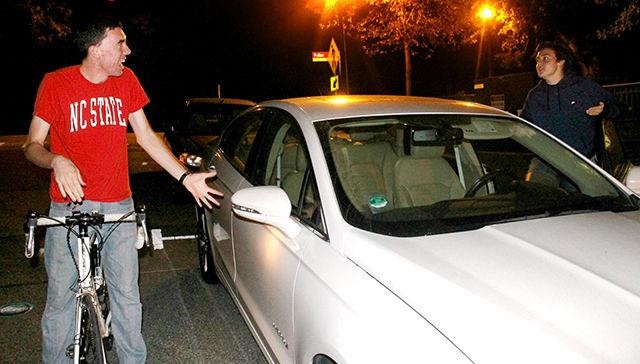
Photo illustration by Jules Conlon
Isaac Warren, a senior studying mechanical engineering, and Lindsey Davis, a junior studying anthropology, dispute the definition of “share the road.” Since the implementation of the share the road” signs, there has been much disagreement between drivers and bikers on whether or not bikers have the right to cycle in the middle of the road.
Although bicycles are classified as vehicles, their motorized counterparts do not always treat them as such. Ambiguous “Share the Road” signs have resulted in miscommunication between cyclists and motorists, according to an NC State study published in the journal PLOS ONE.
Ineffective signage raises skepticism regarding the safety of bicycling in roadways. For decades, a social taboo has existed in U.S. society that places motorists at a higher level of virtue than bicyclists.
“By law, a motorist should wait for traffic to clear before changing lanes to pass the bicyclist because the bicycle is a vehicle and is allowed to use the full lane,” said co-author George Hess, an environmental conservation researcher and professor at NC State. “‘Share the Road’ is a nice sentiment but, in our study, did nothing to improve understanding of how traffic rules relate to bicycles.”
The ubiquitous road signs have only contributed to conflict and confusion. Cyclists believe the message “Share the Road” is directed toward motorists, but motorists think it is warning cyclists to stay out of the way. Ironically, neither belief demonstrates an effective method of sharing the road. Considering Raleigh’s cycling community, placing a straightforward modification to the sign reading “Bicycles May Use Full Lane” would, in effect, expand bicycle use and ease traveling, according to the study.
“We surveyed nearly 2,000 people online, primarily via Twitter,” Hess said. “We found that there was no statistically significant difference between those who saw ‘Share the Road’ signage and those who saw no signage. Among people who don’t bicycle, much or who commute by car, we saw particularly large increases in understanding of traffic laws – and feeling it was safe for bicyclists in the travel lane – when they saw the ‘Bicycles May Use Full Lane’ sign.”
During the study, subjects viewed one of four images. Some saw a street with a traditional “Share the Road” sign; some saw an image of a bicycle painted on the pavement; some saw “Bicycles May Use Full Lane;” and others saw a street without signage.
According to Hess, Delaware is the first state to cease the instillation and phase out the “Share the Road” sign. Wilmington, NC has begun experimenting with alternative signage as well.
“Bicycle traffic can move more people with less congestion than driving personal automobiles, so every person who rides a bicycle makes the traffic congestion better for the remaining drivers,” said Nils Peterson, researcher and co-author of the study and professor at NC State. “The latter point is easy to miss because drivers actually see a slow bicyclist in front of them on occasion but never actually see increased bicycle mode share reducing overall traffic delays.”
The study demonstrates how crucial comprehensibility and clarity are in designing traffic devices.
“Signs definitely influence the behavior of road users,” Peterson said. “If motorists allow cyclists to use the full lane in conditions where passing cannot occur safely inside the lane, lives will be saved.”
Steven Goodridge, former NC State graduate student and developer of the Bicyclist Safety and Law Enforcement online training program, has biked for over 30 years. Goodridge said that biking in the center of the lane completely changed his perspective. According to Goodridge, it is safer to ride in the center of the lane, although it provokes the social taboo that questions what bicyclists should do.
“Since I was a child, I was accustomed to riding my bike as if it was a car,” Goodridge said. “At State, I experienced a culture shock; people didn’t understand why I was riding my bike in the middle of the road. I attempted riding on the sidewalk, but found it far too dangerous.”
Similar to Goodridge, Hess and Peterson are both avid bicyclists.
“It makes me a happier person,” Peterson said. “It wakes me up in the morning and helps me decompress before getting home in the evening. Infusing a small amount of time outside in nature into our daily lives is so important.”
Raleigh is home to an emerging network of cycling advocates, including organizations such as BikeRaleigh, the Bicycle and Pedestrian Advisory Commission, the North Carolina Bicycle Club and The National Center for Bicycling & Walking’s BikeWalk. In the spring, the Oaks and Spokes Festival offers biking events and cultural activities.
“Lots of people are looking for ways to reduce traffic congestion, improve their health, do good things for the environment and save money,” Hess said. “Bicycling addresses all these concerns.”